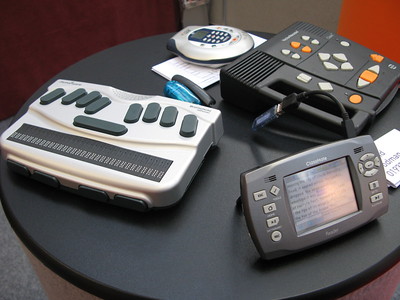Five Assistive Technologies Teachers Should Know

Assistive technology (AT) according to Eduoptia is “any item, piece of equipment, or product system, whether acquired commercially off the shelf, modified, or customized, that is used to increase, maintain, or improve functional capabilities of individuals with disabilities.” This includes a wide variety of no-tech, low-tech, and high-tech tools. Many times educators are using these tools without even realizing it. For example, if you turn on closed captioning during a video, you are using an assistive technology tool. Using the closed captioning benefits those who are hard of hearing and may also aid with reading skills and development. Similarly, many assistive technologies help all students, those with and without learning differences, better access the content. The list below identifies five assistive technologies that you should be aware of:
1. Braille Displays
Braille displays provide access to information on a computer screen by electronically raising and lowering different combinations of pins in braille cells. The refreshable screen of the display changes continuously as the user moves the cursor around on the screen using either the command keys, cursor routing keys, or Windows and screen reader commands. The American Federation for the Blind identifies some models.
2. Talking Calculators
A talking calculator has a built-in speech synthesizer that reads aloud each number, symbol, or operation key a user presses and it also vocalizes the answer to the problem. While the use of a talking calculator is preferred for students with dyscalculia or vision impairments, using this form of AT can benefit all learners to ensure that numbers and operations have been entered correctly.
Casio and Texas Instruments offer several talking models and an Amazon or Google search will provide even more. If preferred, the Talking Calculator app is another option though this app isn’t as comprehensive.
3. Speech to Text Software
Speech to text software has come a long way in recent years. This form of AT allows students and teachers to dictate into their computer, laptop, or smart device and watch their words appear as text on the screen, without having to type anything. If you work in a Google classroom, you can rely on Voice typing (found in the tools tab only in the Chrome browser). Most browsers have their own speech to text tool built into the browser or easily installed with an extension. On a Mac, go to settings and then select Accessibility to view the options; similarly in Windows, navigate to the control panel and then look under ease of access. On Chromebooks, go to settings and look under Accessibility (or install Chrome’s Voicenote extension). Other speech to text tools available for purchase include Speechify and WordPerfect. A useful strategy for teachers is to create a space in a somewhat secluded area of the classroom for voice typing where other classroom sounds won’t be picked up by the microphone. Allowing all students to rotate through this area ensures that everyone has a chance to try it.
4. Visual Timers
A visual timer is a device that makes the concept of time easier to understand and monitor by providing a clear indication of the time remaining and elapsed for tasks. Not only does using a visual timer prepare students for transitions, but these timers can also ease testing anxieties as students can easily see how much time is left. Placing a physical visual timer at the front of the classroom or projecting a digital one on a whiteboard are easy ways to implement this strategy. Some free visual timers can be found at online stopwatch or you can use the visual countdown timer app.
5. Screen Magnification Systems
A screen magnification system enlarges text and graphics on a computer screen. This type of AT functions like a magnifying glass moving around the page aligned with the cursor that the user controls. The magnification speed can be preset and can also be emphasized with colors and shading to help control eye placement. Some highly reviewed screen magnification systems include the Dolphin Guide and iMax for Mac.